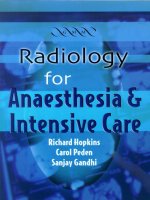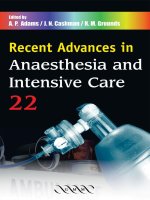Radiology for Anaesthesia and Intensive Care - Part 7 doc
Bạn đang xem bản rút gọn của tài liệu. Xem và tải ngay bản đầy đủ của tài liệu tại đây (824.79 KB, 36 trang )
The cervical spine
4
196
Question 6
Answer
Occipito-atlantal dissociation
This is a generic term that refers to disruption of the occipito-atlantal
articulation that includes partial (subluxation) or complete (dislocation)
disruption [2].
Stability of this joint complex is primarily ligamentous. Frank
occipito-atlantal dislocation is usually a fatal injury (Fig. 4.35). However,
with atlanto-occipital subluxation patients may be neurologically intact.
Other forms of presentation are bulbar-cervical dissociation, lower
cranial nerve deficits with or without cervical cord injury, or worsening
neurological deficit with application of cervical traction.
The diagnosis is easily made by measuring the dens basion interval (DBI)
(Fig. 4.13). The distance does not exceed 12 mm in adults or children.
28-year-old male patient.
The patient required
cardio-pulmonary resuscitation
during ambulance transfer to
hospital.
What is the prognosis
(Fig. 4.35)?
Fig. 4.35 Quiz case.
Chap-04.qxd 09/Oct/02 11:06 AM Page 196
Trauma of the cervical spine
4
197
Fig. 4.37 Quiz case.
Question 7
Male patient. Manual labourer.
Struck (whilst wearing
protective helmet) on top
of head.
Glasgow Coma Score 15/15.
Neurologically intact.
Complaining of neck pain
(Figs 4.36–4.39).
What is the injury?
Fig. 4.36 Quiz case.
Chap-04.qxd 09/Oct/02 11:06 AM Page 197
The cervical spine
4
198
Fig. 4.38 Quiz case.
Fig. 4.39 Quiz case.
Chap-04.qxd 09/Oct/02 11:06 AM Page 198
Trauma of the cervical spine
4
199
Answer
Jefferson fracture
This is usually the result of a vertical compression force (‘blow out’
fracture). The classic Jefferson fracture involves fractures of both the
anterior and posterior arches bilaterally. Usual radiographic features are
displacement of the lateral masses of C1 beyond the margins of the body
of C2 (Figs 4.36 and 4.37). There is approximately a 41% chance of an
associated C2 fracture, thus CT including C1–C3 is recommended [6]
(Figs 4.38 and 4.39). One important caveat; the lack of fusion of the
posterior arch may be seen in adults as a congenital anomaly defined by
smooth margins. This fracture is usually unstable. Usually no neurological
deficit is isolated, due to fragments being forced outwards.
Another important caveat is the rule of Spence. On an AP open mouth
odontoid view, if the sum total of the overhang of both the C1 lateral
masses relative to the body of C2 is greater than or equal to 7 mm,
then the inference is that the transverse ligament is probably disrupted
(which requires rigid immobilisation).
Chap-04.qxd 09/Oct/02 11:06 AM Page 199
The cervical spine
4
200
Question 8
Describe the type of fracture (Figs 4.40 and 4.41).
Fig. 4.40 Quiz case.
Fig. 4.41 Quiz case.
Answer
Odontoid fracture
There are three types:
type 1 – the tip of the odontoid is involved (rare usually stable);
type 2 – odontoid fracture is a fracture of the base of the odontoid
(unstable у 6 mm displacement) (Figs 4.40 and 4.41);
Chap-04.qxd 09/Oct/02 11:06 AM Page 200
Trauma of the cervical spine
4
201
type 3 is a fracture through the base of the odontoid that extends
through the body of the C2 vertebra.
This is usually a stable injury with a good prognosis, and is identified on the
lateral by disruption of Harris’ ring [6] (Figs 4.42–4.44).
Fig. 4.42 Dens fracture. Lateral
cervical spine. A break in the inferior
margin of the sclerotic ring found in
the body of C2 (Harris’ ring), along
with prevertebral soft tissue swelling
(arrow). This indicates a type 3
dens fracture. This can be the only
view where this type of fracture is
identified – on the AP odontoid view
(Fig. 4.44) the fracture is not visible.
Fig. 4.43 Odontoid fracture (dens
fracture). Lateral cervical spine
(close up of Fig. 4.42). Disruption of
this ring (arrow) may be the only
sign of a dens fracture. Soft tissue
thickening at C1 level is also present
(dotted arrows).
Chap-04.qxd 09/Oct/02 11:06 AM Page 201
The cervical spine
4
202
Fig. 4.44 Odontoid (dens fracture).
AP peg view. Same patient
as Fig. 4.42. A fracture through the
body of C2 is not appreciated on
the odontoid peg view.
Chap-04.qxd 09/Oct/02 11:06 AM Page 202
Trauma of the cervical spine
4
203
Question 9
Fig. 4.45 Quiz case.
Fig. 4.46 Quiz case.
Answer
Hangman’s fracture
This is a traumatic spondylolisthesis of the C2 vertebral body resulting
from hyperextension and distraction seen with hanging and from
hyperextension and axial loading in motor vehicle accidents when the chin
strikes the dashboard.
56-year-old female with long
history of depression.
Attempted hanging.
What is this injury called
(Figs 4.45 and 4.46)?
Chap-04.qxd 09/Oct/02 11:06 AM Page 203
The cervical spine
4
204
The radiographic features are
bilateral pars interarticularis fractures of C2 (Figs 4.45 and 4.46),
anterior dislocation of the C2 vertebral body,
anterior inferior avulsion fracture associated with the rupture of the
anterior longitudinal ligament,
prevertebral soft tissue swelling (which can be absent at times).
This type of fracture is associated with a high incidence of head injury.
The fracture is usually stable, however, instability can be identified by
marked anterior displacement of C2 on C3 particularly if the degree
of displacement exceeds more than 50% of the AP diameter of the
C3 vertebral body,
marked motion on flexion/extension films,
excessive angulation greater than 11 degrees.
Neurological deficit is rare, non-union is rare and 90% usually heal with
immobilisation only [6].
Chap-04.qxd 09/Oct/02 11:06 AM Page 204
Trauma of the cervical spine
4
205
Question 10
What is the mechanism of this fracture (Figs 4.47 and 4.48)?
Fig. 4.47 Quiz case.
Fig. 4.48 Quiz case.
Chap-04.qxd 09/Oct/02 11:06 AM Page 205
The cervical spine
4
206
Answer
Extension teardrop fracture
This is usually the result of a hyperextension injury caused by a force
delivered to the face or the mandible that drives the head and neck into
an abnormal extension. The extension teardrop fracture is a relatively
large triangular fragment with its vertical height equal to or greater than
its transverse width. The fractured fragment usually arises from the
antero-inferior corner of the involved vertebra, most commonly
the C2 vertebral body (Figs 4.47 and 4.48). This is an avulsion fracture
at the site of insertion of the intact anterior longitudinal ligament during
hyperextension of the head and upper cervical spine. Extension teardrop
fractures are more common in older patients with osteopenia and
degenerative disease of the spine. This is usually a stable injury in flexion
and unstable in extension [2, 6].
Chap-04.qxd 09/Oct/02 11:06 AM Page 206
Trauma of the cervical spine
4
207
Question 11
What is the name of this fracture (Figs 4.49–4.51)?
What are the radiological features?
Fig. 4.49 Quiz case.
Fig. 4.50 Quiz case.
Chap-04.qxd 09/Oct/02 11:06 AM Page 207
The cervical spine
4
208
Answer
Flexion teardrop injury
This usually results from a severe flexion injury that usually occurs with
neck injuries caused by diving into shallow water, that results in posterior
ligament disruption and an anterior compression fracture of the involved
vertebral body. The radiographic features include:
anterovertebral body avulsion fracture representing the teardrop
fragment
posterovertebral body subluxation or displacement with the disruption
of the posterolongitudinal ligament and compromise of the spinal canal
with resultant anterior compression of the spinal cord.
Other features include fracture of the spinous process and widening of
the interspinous distance due to disruption of the interspinous ligaments,
and prevertebral haematoma associated with anterior ligament disruption
[2, 5, 8].
This is an unstable injury due to complete disruption of the disc,
anterior and posterior ligaments and the facet joints. MRI may help assess
the integrity of the disc and ligaments. Patients are often quadriplegic,
although some may be neurologically intact.
Fig. 4.51 Quiz case.
Chap-04.qxd 09/Oct/02 11:06 AM Page 208
Trauma of the cervical spine
4
209
Question 12
Answer
Locked facet injuries
This is usually the result of a severe flexion injury which can result in
disrupting the normal relationship between the facets. The inferior facet of
the level above is usually posterior to the superior facet of the level below.
Facets that are just before the point of locking are known as perched facets.
Flexion and rotational injury will result in a unilateral locked facet
while an extreme hyperflexion force will result in a bilateral locked facet.
Bilateral locked facets usually present with cervical spinal cord injury and
injury to the cervical roots.
Diagnosis is usually made on the lateral cervical spine and AP
radiographs. Both unilateral and bilateral locked facets will often produce
subluxation. Horizontal subluxation of greater than 3.5 mm of
What is this injury (Fig. 4.52)?
Is this injury associated with
spinal cord damage?
Fig. 4.52 Quiz case.
Chap-04.qxd 09/Oct/02 11:06 AM Page 209
The cervical spine
4
210
one vertebral body on another or greater than 11 degrees of angulation
of one vertebral body relative to the next indicates ligamentous instability.
In unilateral facet dislocation, the AP view of the spinous process above
the subluxation rotate to the same side as the locked facet (see Fig. 4.53).
On the lateral cervical-spine radiograph, ‘bow-tie’ or ‘bat-wing’
appearances of the locked facets is seen referring to visualisation of the
left and right facets at the level of the injury instead of the usual normal
superimposition of the facet joints.
Subluxation may be seen in unilateral locked facets. However, it is almost
always seen in bilateral locked facets with usually greater than 25% of
the vertebral body being subluxed anterior relative to the vertebral body
below. Disruption of the posterior ligamentous complex may produce
widening of the interspinous distance and there may also be a widening of
the disc space. Oblique films may help better demonstrate the locked facets
which usually will be seen blocking the neuroforamina. MRI may be utilised
to assess integrity of the disc space and exclude an extruded disc that could
be impinging on the spinal cord [2, 5, 6].
Fig. 4.53 Locked facets. AP cervical
spine.There is malalignment of the
spinous processes (arrows) at
the C5–C6 level corresponding to the
level of locked facets (Fig. 4.52).
Incidental nodular densities and
smooth pleural thickening at
the left lung apex are calcified
granulomas and pleural reaction
related to previously healed TB.
Chap-04.qxd 09/Oct/02 11:06 AM Page 210
Trauma of the cervical spine
4
211
Question 13
Fig. 4.54 Quiz case.
What is this injury
(Figs 4.54 and 4.55)?
What is the mechanism?
Is the fracture stable?
Fig. 4.55 Quiz case.
Chap-04.qxd 09/Oct/02 11:06 AM Page 211
The cervical spine
4
212
Fig. 4.56 Inadequate cervical spine
film showing down to C6.
Fig. 4.57 CT sagittal reconstruction
demonstrating fracture
dislocation of the C6–C7.
Answer
Clay Shoveler’s fracture
This usually refers to a fracture of the spinous process seen involving the
lower cervical spine, usually C7. Initially described in workers who used
to shovel clay and during the throwing phase, the clay may stick to the
shovel jerking the trapezius or other muscles which are attached to the
cervical spinous processes resulting in an avulsion fracture. This fracture
may also occur with a whiplash injury or injuries that displace the arms
upwards, neck hyperflexion, or a direct blow to the spinous process.
Chap-04.qxd 09/Oct/02 11:06 AM Page 212
Trauma of the cervical spine
4
213
The fracture is stable. If the patient is neurologically intact, further
imaging with flexion extension views or CT scans of the affected level to
rule out other occult fractures that might have been missed on plain film
radiography is recommended. A rigid collar may be used as needed for pain.
The radiographic features on the lateral view reveal avulsion type
fracture involving the spinous process and on the AP view a ghost sign is
seen referring to a double spinous process of C6 and C7 (Fig. 4.55) resulting
from usually caudal displacement of the fractured spinous process [2, 5, 6].
Complete radiographic assessment
The need to adequately image the cervical spine from C1 to C7–T1
cannot be overemphasised. The examples above (Figs 4.56 and 4.57)
demonstrate the pitfalls of incomplete examination of the cervical spine.
If the complete cervical spine cannot be visualised on plain films,
then cross-sectional imaging is mandatory.
References
1. H.K. Lyerly, J.W. Gaynor. The Handbook of Surgical Intensive Care, 3rd edition, 1992.
2. John H. Harris Jr., Stuart E. Mirvis. The Radiology of the Acute Cervical Spine Trauma,
3rd edition, 1996.
3. R.K. MacDonald, M.L. Schwartz, D. Mirich, P.W. Sharkey, W.R. Nelson. Diagnosis of cervical
spine injury in motor vehicle crash victims: how many X-rays are enough? J Trauma 1990;
30: 392–397.
4. Emergency and Trauma Radiology, 2000. Categorical Course Syllabus, American Roentgen
Ray Society Meeting.
5. Adam Greenspan. Orthopedic Radiology. A Practical Approach, 3rd edition, 2000.
Lippincott Williams and Wilkins, Philadelphia.
6. Mark S. Greenberg. Handbook of Neurosurgery, 5th edition, 2001.
7. R.H. Daffner. Thoracic and lumbar vertebral trauma. Orthopaedic Clinics of North America
1990; 21(3): 462–482.
8. P. Ford, J. Nolan. Cervical Spine Injury and Airway Management. Current Opinion in
Anaesthesiology 2002; 15: 193–201.
9. S.B. Gay, R.J. Woodcock Jr. Radiology Recall, 2000.
10. N. Müller, Fraser, Colman, Pare. Radiologic Diagnosis of Disease of the Chest, 2001.
Chap-04.qxd 09/Oct/02 11:06 AM Page 213
This page intentionally left blank
5
CT Head
Principles of CT image formation 216
Principles of interpreting CT 219
Case illustrations 220
215
Chap-05.qxd 09/Oct/02 11:06 AM Page 215
Principles of CT image formation
How does CT work?
CT was discovered in 1972 by G.N. Hounsfield and since then its use has
steadily grown so that now it is the workhorse of medical imaging.
The original scanners took several minutes to take a single slice of the head
but now the whole body can be scanned in 1–2 minutes. The scope of CT
has increased from initially just head scans to current applications in all
body systems.
A CT machine is comprised of the gantry, the table where the patient lies
and the computer for operating the scanner and viewing images. The
gantry is the large square giant donut with a patient aperture into which
the patient is fed upon the table. The gantry is composed of a generator,
X-ray tube, collimator and detectors. The gantry can be tilted to various
degrees of angulation relative to a true perpendicular or axial slice. The
X-ray tube circles the patient and produces a fan-shaped X-ray beam, the
width of which is determined by collimators. The beam travels through
the patient and is absorbed by a ring of detectors on the far side. The
intensity of the X-rays reaching the detectors is recorded (an electrical
current is generated that is proportional to the X-rays impinging on the
detectors) and this depends on the absorbtion characteristics of the tissues
through which the beam has passed. The X-ray beam is rotating around the
patient so that each tiny block of tissue is exposed from multiple different
directions. Using a sophisticated mathematical process called Fourier
analysis, it is possible to allocate each tiny block of tissue a density value
and exact position within the body. CT, although much more sophisticated
than plain film radiography, relies on the same basic principle of dense
structures blocking X-ray transmission. Each point on a CT image represents
a volume of tissue or voxel. The units of relative density on CT are named
after its inventor Hounsfield – Hounsfield units (HU). By definition, water
has a density of 0 HU. An HU is a measure of linear attenuation coefficient
compared to water. Further examples are listed below:
bone: 400 HU,
soft tissues: 80 HU,
water: 0 HU,
fat: Ϫ40.
A pixel is a two-dimensional representation of a three-dimensional block
of tissue or voxel. Each pixel in the CT image is allocated a shade of grey
depending on its density.
CT windows are a method of optimally displaying the shades of grey in a
CT image. Windows have a level (the central HU valve) and a width, the
range of CT valves displayed. In abdominal CT, the level may be 35 with a
width of 400 – so that the CT demonstrates structures from Ϫ165 to ϩ235 HU.
CT head
5
216
Chap-05.qxd 09/Oct/02 11:06 AM Page 216
A narrow window like this is used when structures have similar densities in
order to ‘spread out’ subtle changes in density. In the example above,
values of greater than 235 would be shown as white and below Ϫ165 as
black. Different CT windows are used to view different anatomical areas
scanned, e.g. brain, posterior fossa, mediastinum, lung, liver, abdomen and
bone all have different windows for image display.
What is spiral or helical CT?
The most significant advance in CT over the past few years has been the
development of spiral CT. Conventional CT produces a data set for each
individual slice scanned. The table moves to a location and the tube rotates
to acquire data and the process is repeated for the next slice/position.
There are cables in the gantry which means that between slices the tube
has to reposition. Conventional machines are start stop scanners. Spiral CT
continuously scans the patient as the table feeds through the gantry. X-ray
exposure, table movement and data acquisition occur simultaneously. This
produces a volume set of data of the entire region scanned. This is possible
due to slip ring contacts (no constricting cables need to be unwound
between slices). It is much quicker, and reduces problems from patient
breathing – misregistration of images (on a conventional scanner a lesion
may not appear on the scan if a patient takes a slightly different breath
on two subsequent slices). The data set acquired is then reconstructed to
represent axial slices. Images are easily reconstructed into different planes.
What is multi-slice CT?
With multi-slice CT, a single gantry rotation will capture multiple images,
e.g. with quadslice CT, each gantry rotation captures four slices of data.
The great advantage of multi-slice CT is its speed and its ability to cover
large anatomical areas with thin collimation. There is no associated reduction
in image quality. There are numerous applications including global trauma
assessment (head, cervical spine, chest, abdomen and pelvis), vascular
imaging, pulmonary embolism, virtual colonoscopy, lung cancer screening
and cardiac imaging. One of the advantages of multi-detector CT is the
ability to image organs in various phases of intravenous contrast
enhancement – for instance, the pancreas can be scanned in arterial,
parenchymal and portal venous phases with a single contrast injection.
Intravenous contrast medium
Intravenous contrast used in CT is an iodine-based contrast similar to that
used for IVPs and numerous other radiological procedures. The iodine in
the contrast causes X-ray absorption so that vascular structures and organs
taking up the contrast medium appear more dense during the
examination. This improves the contrast resolution between vascular and
non-vascular structures. Contraindications to intravenous contrast include
known contrast allergy, renal impairment and diabetic patients taking
Metformin.
Principles of CT image formation
5
217
Chap-05.qxd 09/Oct/02 11:06 AM Page 217
The contrast is administered via an intravenous cannula and the timing
of administration is carefully controlled to coordinate with the timing of
the CT scan. Various phases of contrast enhancement occur as the bolus
of contrast passes from the arterial system into the veins and is finally
excreted in the kidneys. The timing of the scan is dependent on the organ
of interest and arterial phase, parenchymal, venous or delayed imaging (for
instance, to show contrast in the ureters or bladder) can all be performed.
CT protocols
CT protocols are becoming more complex with the use of fast multi-slice
scanners. Protocols are designed to optimally image a particular organ or
body system. Other ways of optimising a scan include:
patient positioning (prone or supine);
breath holding;
gantry tilt;
varying CT slice thickness;
oral contrast (either positive contrast or water contrast);
rectal or bladder contrast;
intravenous contrast;
timing of the scan with respect to the intravenous contrast bolus;
use of additional drugs, e.g. Buscopan to arrest bowel movement.
CT head
5
218
Chap-05.qxd 09/Oct/02 11:06 AM Page 218
Principles of interpreting CT
CT head
The assessment of CT of the head depends on a good knowledge of
normal brain anatomy. The left and right sides of the brain are basically
symmetrical and the identification of asymmetry is invaluable in diagnosing
pathology. The nature or composition of the tissues can be determined by
looking at its density or Hounsfield value. There are broadly speaking only
four categories of density. These are bone or calcification which is very
dense and bright white, soft tissue density which is a variety of shades of
grey, fat density which is dark grey and air which is black. By applying these
principles, it is possible to determine the composition of a tissue seen on
any CT scan, and a head CT scan in particular. Look at the different types of
tissue in the normal anatomy sections – Question 1. The lateral ventricles
and cerebral cisterns contain CSF which is water density, i.e. grey. Scalp fat
is dark grey. All the bony structures and any calcification (for instance,
in the choroid plexus) is bright white.
A CT scan takes axial slices through the head and by convention
the anatomical right side is displayed to the right side of the page.
It is like looking up at an axial section of the body from below.
This should be obvious from the labelling of the scan.
CT head scans may be presented on either bony windows or brain
windows. The reason for this is to optimise the appearance of the
structures being investigated. Digital imaging has difficulty in displaying
the full range of densities; so if a skull fracture is likely, then the images
must be looked at on bone windows; but if the problem is intracerebral,
then brain windows are necessary.
The majority of CT head scans performed for trauma are plain or
without any intravenous contrast enhancement. It can be important to
know whether a CT head scan was performed with or without contrast
media. Often, the film will be labelled contrast or C. Contrast can be seen
in the vessels or venous sinuses. Some lesions are dense, i.e. white without
contrast enhancement and these can potentially be confused with avidly
enhancing tumours, if it is not known whether contrast has been given.
Acute blood is dense or white on CT head scans, so it is possible to date
a haematoma on the basis of its density. As the haematoma matures,
the density gradually reduces (see Question 3). When fully mature, it can
have almost the same density as CSF. The following cases and subsequent
explanations demonstrate normal anatomy and the most commonly
encountered pathologies seen in CT head examination. The pathologies are
those most likely to be encountered in anaesthetic practice.
Principles of interpreting CT
5
219
Chap-05.qxd 09/Oct/02 11:06 AM Page 219
Case illustrations
Question 1
What are the normal anatomical structures labelled (Figs 5.1–5.4)?
CT head
5
220
Fig. 5.2 Quiz case.
Fig. 5.1 Quiz case.
Chap-05.qxd 09/Oct/02 11:06 AM Page 220









